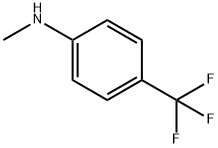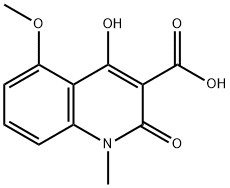| Identification | Back Directory | [Name]
tasquinimod | [CAS]
254964-60-8 | [Synonyms]
ABR-215050
tasquinimod
Tasquinimod, >98%
Tasquinimod(ABR-215050)
ABR-215050; ABR215050; ABR 215050
4-Hydroxy-5-methoxy-N,1-dimethyl-2-oxo-N-(4-(trifluoromethyl)-phenyl)-1,2-dihydroquinoline-3-c
1,2-dihydro-4-hydroxy-5-methoxy-N,1-dimethyl-2-oxo-N-[4-trifluoromethyl)phenyl]-3-quinolinecarboxamide
4-Hydroxy-N-[4-(trifluoromethyl)phenyl]-5-methoxy-N,1-dimethyl-2-oxo-1,2-dihydroquinoline-3-carboxamide
3-QuinolinecarboxaMide, 1,2-dihydro-4-hydroxy-5-Methoxy-N,1-diMethyl-2-oxo-N-[4-(trifluoroMethyl)phenyl]-
4-Hydroxy-5-methoxy-N-methyl-1-methyl-2-oxo-N-(4-trifluoromethylphenyl)-1,2-dihydroquinoline-3-carboxamide
N-Methyl-N-(4-trifluoromethylphenyl)-1,2-dihydro-4-hydroxy-5-methoxy-1-methyl-2-oxoquinoline-3-carboxamide
4-Hydroxy-5-Methoxy-1-Methyl-2-oxo-1,2-
dihydro-quinoline-3-carboxylic acid Methyl-
(4-trifluoroMethyl-phenyl)-aMide | [Molecular Formula]
C20H17F3N2O4 | [MDL Number]
MFCD18251454 | [MOL File]
254964-60-8.mol | [Molecular Weight]
406.36 |
| Chemical Properties | Back Directory | [Boiling point ]
501.5±50.0 °C(Predicted) | [density ]
1.427±0.06 g/cm3(Predicted) | [storage temp. ]
Sealed in dry,2-8°C | [solubility ]
insoluble in H2O; ≥20.32 mg/mL in DMSO; ≥4.75 mg/mL in EtOH with gentle warming and ultrasonic | [form ]
solid | [pka]
4.50±1.00(Predicted) | [color ]
White to light yellow |
| Hazard Information | Back Directory | [Description]
Tasquinimod is an orally-active quinoline-3-carboxamide derived from roquinimex, an immunomodulatory quinolone with applications in some cancers and autoimmune diseases. Tasquinimod inhibits tumor angiogenesis and supplements radiation or chemotherapy in animal models of prostate cancer. While its precise mechanism of action remains unclear, tasquinimod has been reported to alter signaling through S100A9, thrombospondin-1, HIF-1α, androgen receptor, VEGF, and HDAC3/4. | [Uses]
Tasquinimod is an orally active antiangiogenic agent which may inhibit HDAC4 signalling. This affects cancer cell survival thus making this compound and anti-cancer agent. | [Synthesis]
General procedure for Example 8 N-methyl-N-(4-trifluoromethylphenyl)-1,2-dihydro-4-hydroxy-5-methoxy-1-methyl-2-oxoquinoline-3-carboxamide (Method B): 1,2-dihydro-4-hydroxy-5-methoxy-1-methyl-2-oxoquinoline-3-carboxylic acid (8 g, 0.032 mol) and triethylamine ( 15.5 ml, 0.11 mol) were dissolved in 10 ml of dichloromethane and cooled to 0°C. Within 0.5 h, 150 ml of a dichloromethane solution of thionyl chloride (3.0 ml, 0.042 mol) was added dropwise to this solution while maintaining the temperature at 4°C. After the dropwise addition, stirring was continued at 4°C for 4 hours. After completion of the reaction, the reaction mixture was diluted with 10 ml of dichloromethane and washed sequentially with cold 1 M sulfuric acid and 1 M sodium hydroxide solution. The pH of the aqueous phase was adjusted to 8-8.5, clarified by filtration and acidified with hydrochloric acid to pH 4. Upon standing, a crystalline precipitate was formed, the precipitate was collected by filtration, washed with water and dried to afford the target product 4-hydroxy-5-methoxy-N,1-dimethyl-2-oxo-N-(4-(trifluoromethyl)phenyl)-1,2-dihydroquinoline-3-carboxamide (8.5 g, 65% yield). The product was structurally confirmed by 1H NMR and 13C NMR and analyzed by ESI MS/MS. | [in vivo]
The bioavailability and oral absorption of Tasquinimod is excellent when adult male mice (i.e., C57Bl/6J, or athymic nude mice) are given 0.1-30 mg/kg (i.e., 0.2-74 μmoles/kg) via gavage or the drinking water. The potency of Tasquinimod expressed as the daily oral dose of Tasquinimod which inhibits cancer growth by 50% ranges from 0.1-1.0 mg/kg/d (i.e., 0.24-2.40 μmoles/kg/day) against a series (n>5) of human prostate cancer xenografts in immune-deficient mice. Tasquinimod at a chronic dose of 5 mg/kg/day via the drinking water produces > 80% inhibition (p<0.05) of TRAMP-C2 mouse prostate cancer growth in immune-competent syngeneic mice[2]. Nude mice carrying subcutaneous LNCaP tumors are treated with Tasquinimod for 3 weeks. Exposure to Tasquinimod at 1 mg/kg/day and 10 mg/kg/day started on day 7 after inoculation. There is a statistically significant dose dependent reduction in tumor weight both at 1 mg/kg/day and 10 mg/kg/day compare to the untreated control group 28 days after inoculation (p<0.001), illustrating the anti-tumor effect of Tasquinimod[3]. | [target]
tumor microenvironment | [IC 50]
HDAC4: 10-30 nM (Kd) | [storage]
Store at -20°C | [References]
[1] Patent: US6133285, 2000, A
[2] Patent: EP1095021, 2003, B1. Location in patent: Page/Page column 9 |
|
|








